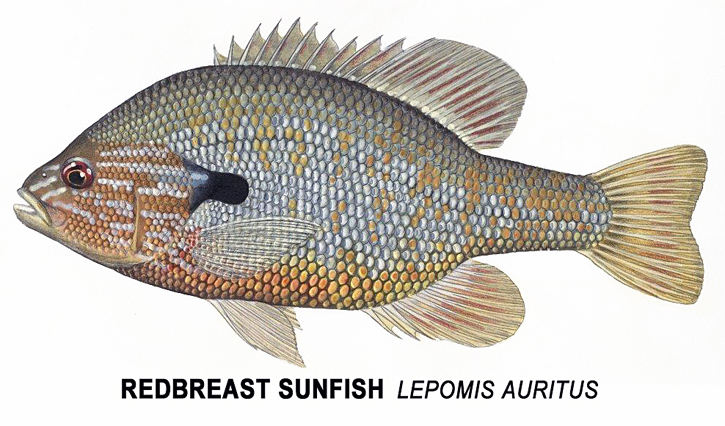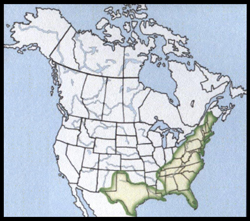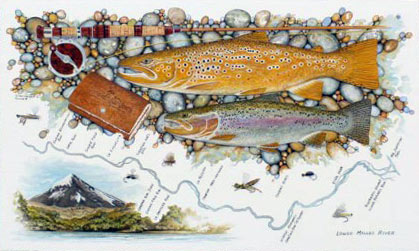Redbreast Sunfish, July 2014, Fish of the Month!
A Brief Note to Our Readers:
A brief note about this family of Fishes: The Sunfish family includes a large number of very North American species. We're including many of them here (in spite of their often small size) because they make excellent warm-water training species for young anglers and because adult warm-water fly-fishers are likely to often take them as incidental catches and would like to know what species they've brought to hand.
 Redbreast sunfish
Redbreast sunfish
Lepomis auritus
Local Names:
Robin, Long-eared bream, Red perch, Red brim, Sun perch
Average Size:
5 to 8 inches
Distinguishing Field Marks:
(See the illustration.)
-
The long black ear flap is a reliable field mark.
-
There are light blue streaks on the gill covers, cheeks, and snout.
-
The base color of the eye is red.
The lower jaw protrudes slightly beyond the upper.
The mouth is small.
North American Range:
Map to the right shows approximate range in North America.
Diet:
Primarily immature aquatic insects and other invertebrates, sometimes augmented by the inclusion of small fishes.
Biology:
Typical of all our small Sunfishes' spawning behaviors:
After spending the winter months in schools known as "winter aggregations," from which they disperse when the water temperature has reached 50 degrees F. in deep water, male Redbreast sunfish move into shallow areas and begin defending a chosen area and clearing their nests in water 6 to 18 inches deep. When the nests are ready, females enter the nesting grounds, which may, in typical sunfish fashion, be in a crowded colony. The males move quickly toward a chosen mate and swim in circles around and over her, and then lead her back to the nest. The pair hovers over the nest, then turns head to tail, and releases small batches of eggs and sperm. The females usually move to other nests and mate with other males before spawning is finished, at which point they move out of the spawning areas, leaving the males to keep a flow of oxygen through the eggs by fanning them with their anal and caudal fins, guard the eggs until they hatch, and then continue to protect the young until they are large enough to fend for themselves.
Adult Redbreast sunfish may be found in a variety of habitats, but tend to favor deeper waters than some of their nearest relatives. They are often found over rocky bottoms in streams, ponds, and lakes but will also shelter around emergent vegetation. Like the Rock bass, Redbreast sunfish will dart into the cover of rocky crevices when disturbed.
Fly Fishing for Redbreast Sunfish:
Like all our small Sunfishes, the Redbreast will actively accept a broad assortment of artificial flies. Wet flies, such as unweighted and weighted Wooly Buggers, Wooly Worms, and many other suggestive, rather than imitative patterns, will entice these brightly colored fish to take. Foam beetles, ants, and small popping bugs are the go-to flies for top-water fly fishing for all our smaller Sunfish species. Because these small fish have small mouths, flies and poppers tied on hooks larger than size 10 can actually prevent your hooking them.
If you're targeting these small but aggressive fish, you'll want an outfit in the 4 to 6 weight class…..Rod length is optional: 7'6" to 8' for small brushy streams and tree-lined still-water bank fishing, and on up to 9' for casting from your water craft of choice.
Significance to Humans:
Is minimal and is only as a minor sport fish which is sometimes eaten. Like all the small Sunfishes, the Redbreast makes and excellent entrée for those willing to carefully prepare it.
The Redbreast is another of our small Sunfishes that does well on a diet of live food in a home aquarium.
Status:
Maintaining, exclusively through natural reproduction.






